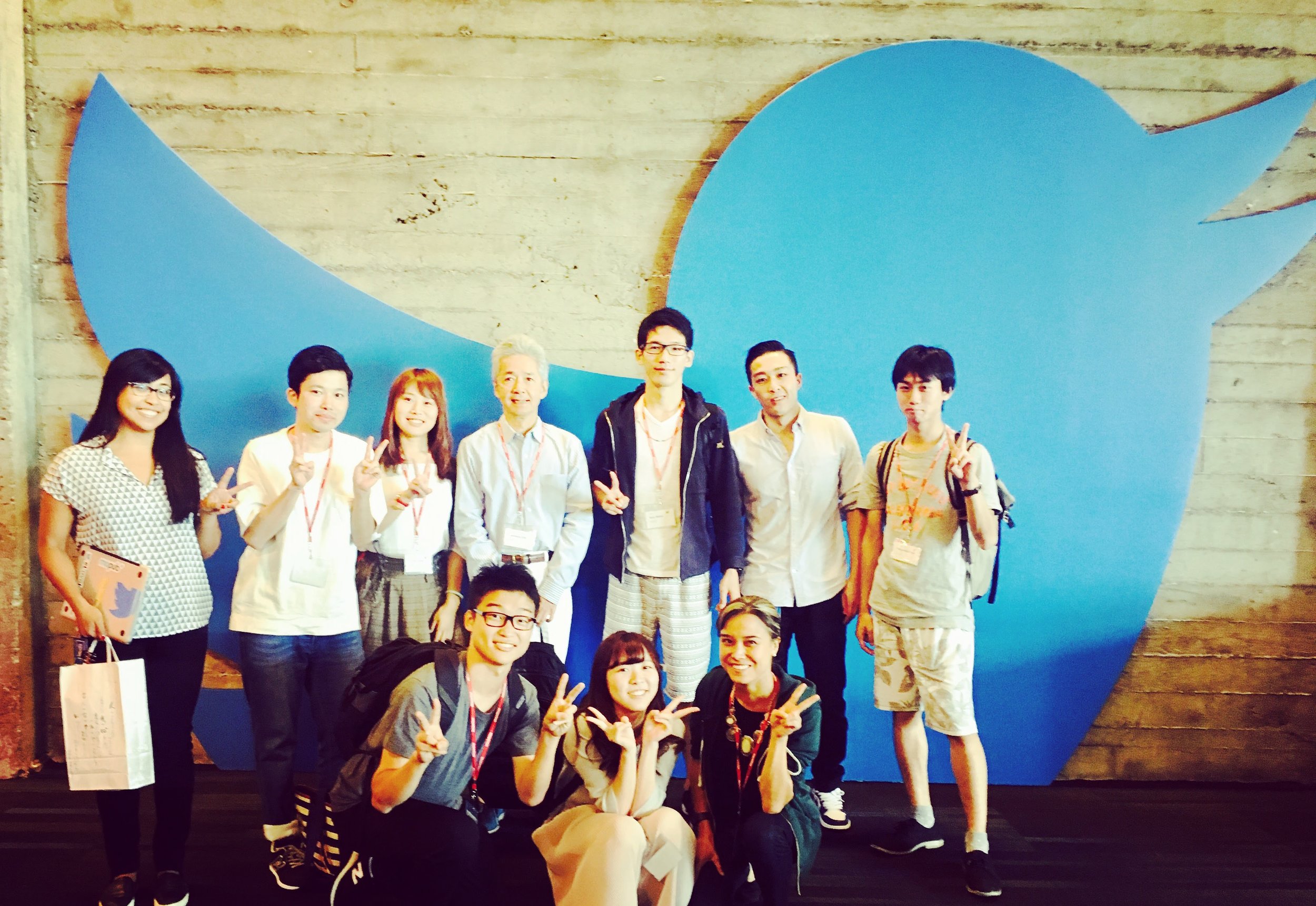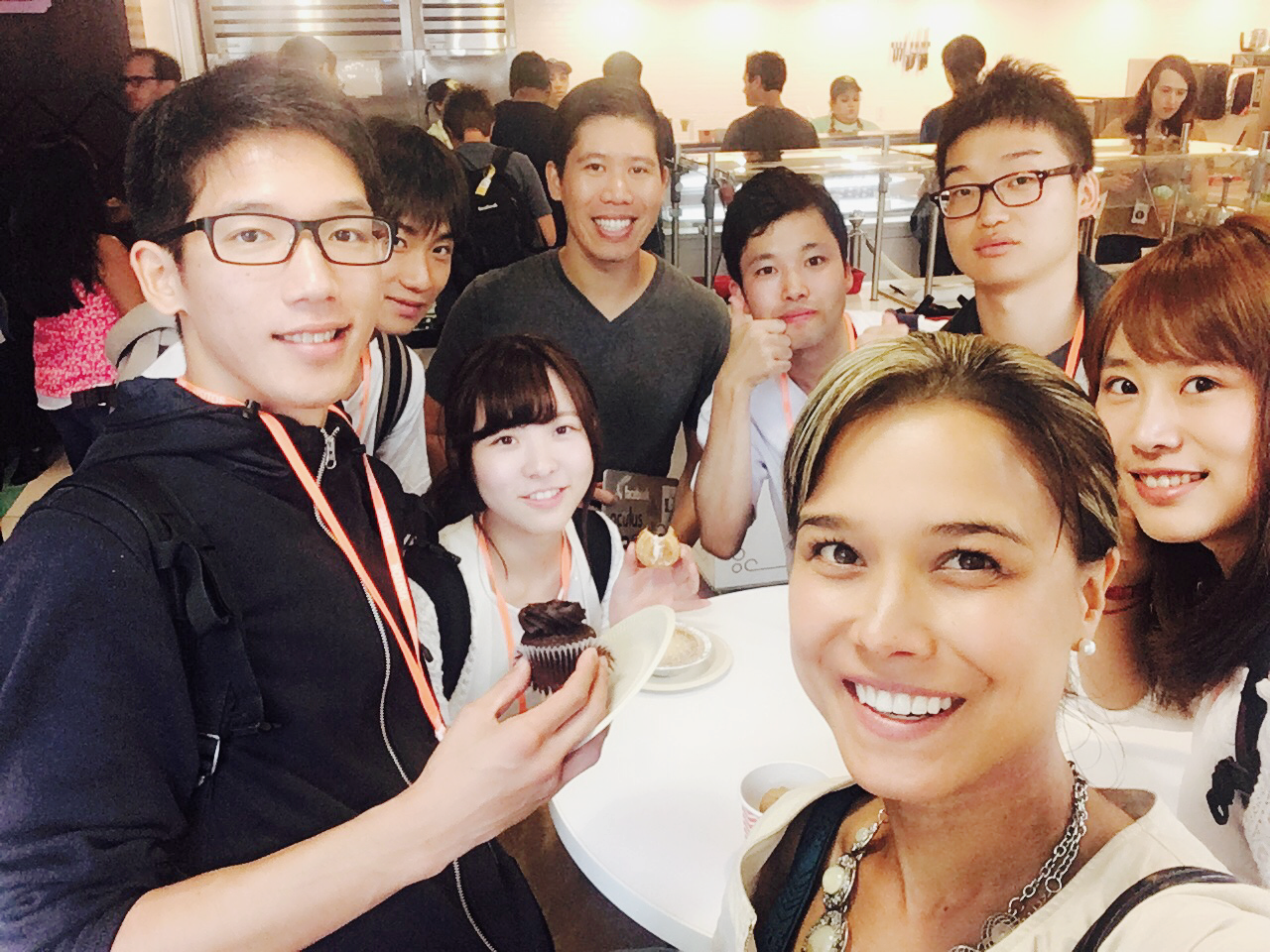Venturing into Silicon Valley's Top Technology Companies — Part 1 | シリコンバレーのトップテクノロジー企業の冒険
Over the course of five days in early August 2017, six Kyoto University undergraduate students, my Professor — Chihiro Suematsu — and I, visited six of the top technology companies in the San Francisco Bay Area. We were fortunate enough to visit my former colleagues and extended network at Twitter, Facebook, Amazon, Apple, Airbnb, and Google.
Company Visits
Day 1: Twitter
Day 2: Facebook
Day 3: Amazon & Apple
Day 4: Airbnb & San Francisco SGI Culture Center
Day 5: Google
I’d like to express my deep appreciation to our countless hosts, both this year and last year, as well as my professor for making this Silicon Valley trip a reality.
In Part 1, I will highlight the main takeaways of our visits at the first 3 companies: Twitter, Facebook, and Amazon. In Part 2, I will share key information about the final 3 companies: Apple, Airbnb, and Google.
1. One of our meetings was with a top lawyer at Twitter, who used to be my manager at Google. He eloquently described the importance of defending and respecting the user’s voice. As defined in the company values — “we believe in free expression and think every voice has the power to impact the world” — Twitter employees actively build on this philosophy to passionately argue their point of view. The lawyer explained how these impassioned arguments coexist with consensus-based, decision-making, as everyone bases their arguments around the company mission.
2. When asked to describe the company, the lawyer used only one word — soulful. With a deep sense of defending and respecting the user’s voice, it’s no wonder why he would describe the company as soulful.
Soulful to me, means passionate, heartfelt, sincere, and deep — not superficial and meaningless, but rather, if I may extrapolate, Twitter employees feel a meaningful connection to humanity by empowering them with a platform to share their voice.
3. My friends, Jennifer Gines —Sales Strategy and Operations at Twitter — and Timothy Chen, —Corporate Development and Strategy at Twitter — described the working style at Twitter that promotes autonomy, structured chaos, and delegation of tasks to empower team members.
4. Jennifer and Tim shared Twitter’s inclusive, gender-neutral parental policy leave, guaranteeing any parent up to 20 weeks of 100% paid time off. That's incredible! With the opportunity of 5 months of paid maternity or paternity leave, heterosexual and same sex couples, now have the unique opportunity to participate in household and childcare duties.
Will this mere fact help encourage more folks to join this illustrious and inclusive company? I think so!
1. In our meetings with Derrick Leong — Recruiter — and Justin Tse, — Program Manager of Mission Control at Facebook — the pair emphasized the importance of a highly efficient workforce that encourages autonomous problem solving, coupled with excellent communication and collaboration across various teams in disparate regions of the world. And when you take a look at Facebook's company values, you begin to understand the company culture on a deeper level.
A. Focus on impact by moving fast and building things.
B. Be bold and courageously take risks.
C. Move fast and don't worry about making mistakes.
D. Be open and transparent to create a better world.
2. Like Twitter, Facebook also has an outstanding parental policy leave, as well as a generous bereavement leave policy. But what impressed me the most was its innovative use of prime parking spots. In typical companies, university campuses, and even your local Walgreens or CVS, the prime real estate for parking always goes to disabled and handicapped folks, which completely makes sense. And while Facebook also has the typical spots available for disabled folks, it goes above-and-beyond others by providing the best parking spots for expectant mothers on its HQ campus. Check out this incredible sign!
3. Another interesting fact about the company's origins, is its graffiti art that adorns the main lobby. The business-savvy artist bet on the company's future success, when he asked for company stock in lieu of payment, which at the time, the owners thought was a good deal, readily accepted. Now, the man is a multi-millionaire! And better yet, his artwork still adorns the offices to this day.
4. According to Derrick and Justin, Facebook works very hard to hire with the right cultural fit in mind. Through employee referrals, active recruitment of top individuals, and rigorous interviews, Facebook does its very best to hire people who not only have the technical expertise, but also the right cultural fit. At Facebook, this means that potential employees are hired because of their passion, their sense of urgency, and their infectious energy.
To mitigate any poor hiring decisions — even with intense vetting processes — the company also fires people quickly. Getting fired, is a concept that is unfamiliar to most Japanese people, as they typically have guaranteed, lifetime employment. While “at will” employment has both pros and cons, I believe it creates a more hard-working workforce in America. Whereas, in Japan, people already work extremely hard, so it wouldn't be as valuable to implement an “at will” policy.
AMAZON
1. In our meeting with David Huynh — Product at Amazon — he shared his personal, very positive perspective about Amazon's culture, its way of doing business, its leadership principles, and its management. Through David's enthusiasm, infectious energy, and passion for the company, we all left the meeting feeling like we too, wanted to watch all of Jeff Bezos public videos online, and read more about the company's philosophy.
2. Jeff Bezos insists on the highest standards, which he constantly elevates...thereby, challenging the employees to continually go above-and-beyond, while also having the courage to drive projects that may not make any money for the foreseeable future. In 2016, Jeff Bezos declared Amazon as the “best place in the world to fail at.” That's because without risk, there can be no growth of any kind. And with the top leadership promoting a risk-taking culture, it's no wonder that Amazon is now one of the most successful companies in the world.
3. By constantly pushing the envelope, Amazon employees have the opportunity to develop cutting-edge technology and increase their personal set of skills. Employees apparently love the fact that by doing the hard work and demonstrating data-backed results, they can be the one to make the most important decisions and potentially drive projects from start-to-finish like mini-entrepreneurs.
In sum, employees are encouraged to act like an executive — an executive who provides quantifiable results and relates it back to Amazon's leadership principles.
4. What's even more interesting, is the customer-oriented mindset at Amazon. Instead of using Powerpoint presentations at internal company meetings, all Amazon employees, who are planning to launch a new initiative or product, must write a 6-page PR FAQ.
Basically, this document is a Press Release, written from the perspective of an already-launched product or service. Thus, employees are forced to work backwards. They start by considering the value-add to future customers, its features, its benefits, etc. For example, Why does Bob need this new product? What problem is it solving? How will it be used? How much will it cost? Why should he buy it? Who else can it help?
By writing abut a new product or service from the external perspective with the core customer in mind, the authors has to ask themselves, “If I were the customer, what would I want to know?”
Then, at the start of everything meeting related to this potential product, every participant will receive a copy of the document, whereupon everyone will spend the first ~20-30 minutes reading the document — silently, together. Once everyone is done reading the PR FAQ, the group will start to ask clarifying questions, critiquing specific points, and suggesting additional ideas.
After anywhere between 3 and 300 meetings, where participants discus the product with a continuously-enhanced document, the author and project leader will finally receive the go-ahead to launch the initiative!
Thank you very much for reading Part 1!
Enjoy other articles with female founders in a variety of industries.
Technology
Shaherose Charania — Founder of Women 2.0, a Network of Global Female Tech Entrepreneurs & Supporters
Akiko Naka — Founder of Wantedly, a Professional Networking Service (Link to Japanese Article)
Yuka Fujii — Founder of Famarry, an Online Platform to Connect Photographers with Users
Chika Tsunoda — Founder of Anytimes, an Online Skill-Share Platform
Mariko Fukui — Founder of Aalto International, a Global Branding & PR Firm
Emi Takemura Miller — Founder of Peatix.com, a Mobile Event Platform & an NPO
Machi Takahashi Masuoka — Founder of Stroly, a Creative & Collaborative Map Platform
Health
Kay Deguchi — Founder of Ochanomizu Orthopoedic Clinic, an Innovative Rehabilitation Center
Omima M. Miki — Founder of an NPO & a Tokyo Resort Onsen Opening in 2019
Kanoko Oishi — Founder of Mediva, a Patient-Centered Medical Facility
Atsuko Mori — Founder of a Traditional Matcha Tearoom in Kyoto
Retail
Yukiko Yamamoto — Founder of a Design Studio for Kimono Accessories in Kyoto
Harue Itoh — Founder of a High-end Women's Fashion Store in Kyoto
Kazuyo Saka — Founder of a High-end Women's Fashion Store in Tokyo
Ritsuko Tominaga — Founder of a retail & manufacturing consultancy, Re-mix Co. in Osaka.
Education
Sachiko Okamoto — Founder of an English Language School in Kameoka, Kyoto Prefecture
Yoko Yamada — Founder of a Business Manners Consulting Company in Japan
Cuisine
Miki Yamamoto — Founder of a Famous Bakery in Kameoka, Kyoto Prefecture













